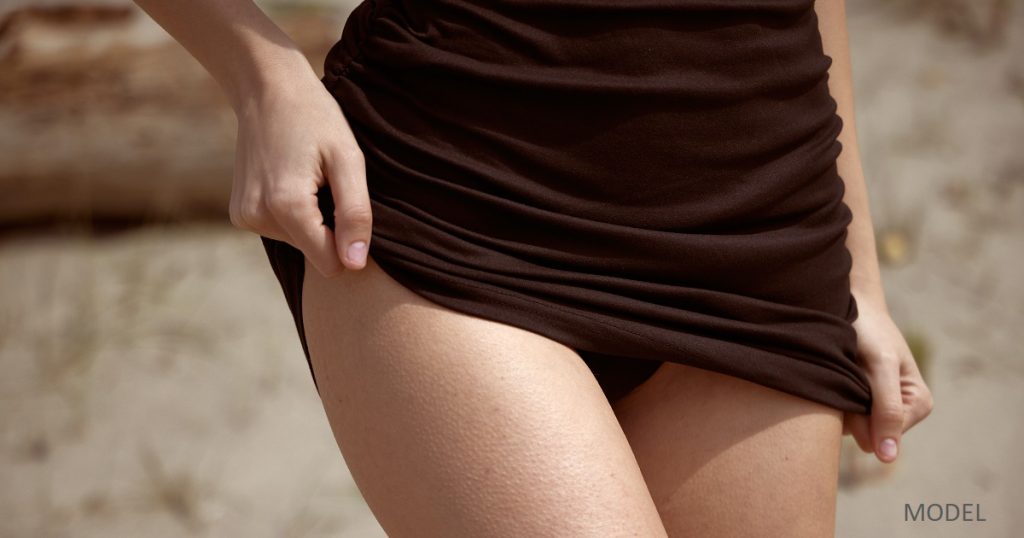The patients I see for thigh lift consults at my San Antonio plastic surgery practice typically are bothered by their inner or outer thighs. The changes in their thighs are typically due to weight loss, prior pregnancies, or simply because of the aging process. A thigh lift is designed to remove excess skin and pockets of unwanted fat to reshape the thighs, resulting in a more balanced, toned appearance.
If you are interested in learning if you are a good candidate for a thigh lift, request a consultation or call (210) 942-6672 to make an appointment.
What Kind of Incisions Are Used for a Thigh Lift?
Choosing the right incision placement partly depends on where the excess skin exists. If the skin excess is only in the upper third of the thigh, a horizontal incision in the fold of the groin area may be sufficient, but if skin laxity extends down the leg, a vertical incision helps achieve a natural thigh shape when performing a thigh lift.
When I perform a thigh lift using a vertical incision, I place the incision on the inside of the thigh. When using a horizontal incision, I place the incision close to the groin crease – both are fairly well camouflaged when looking from the front or the back after surgery.
Does a Thigh Lift Help with Cellulite?
I often hear questions regarding cellulite during a thigh lift consultation with female patients.
Cellulite appears as a “dimpling” or indentations on the skin of the thighs or the buttocks. A variety of factors can influence cellulite, but the cause remains unclear. The anatomical cause of cellulite appears to be a tethering of the skin by fibrous bands, called septa, to underlying structures in the deep layers of the skin.
Most modern cellulite treatments focus on releasing the septa which cause the dimpling of the skin.
A thigh lift procedure is not geared to release the septa and therefore is not a meaningful treatment for cellulite. A thigh lift is designed to remove excess skin and tighten the remaining skin, but it does not affect the underlying structure of the skin or cellulite.
Can a Thigh Lift or Liposuction Help with Lipedema or Lymphedema?
Lipedema
Lipedema is characterized by a localized deposition of adipose fat, typically located in the buttocks or thighs, and most commonly appears in women, though men can experience lipedema as well.
Lipedema can occur in patients that are overweight or of at a normal weight. It often first appears around puberty. It tends to be a genetic trait. Patients who have lipedema typically describe a family history of “fat legs.”
When discussing treatment for lipedema, I first encourage healthy lifestyle modifications. Surgical treatments like a thigh lift or liposuction can help to remove the subcutaneous fat deposits.
Lymphedema
Lymphedema typically is identified as a localized swelling of an extremity due to a lymphatic disruption. This condition requires a blood work up and imaging before determining the appropriate treatment.
How to Differentiate Between Lipedema and Lymphedema
One way to differentiate lipedema from lymphedema is that swelling caused by lipedema stops at the ankles – the feet do not swell.
In order to determine whether you have lipedema, lymphedema, or large legs due to obesity, it is important to have a clinical examination and discussion of your medical history with a qualified surgeon before considering treatment.
Oftentimes imaging studies can help in guiding how to manage disproportionally enlarged legs. From there, your doctor can provide a recommendation for treatment and determine whether or not you are a good candidate for a thigh lift or another procedure such as liposuction.
Is Liposuction Included with a Thigh Lift?
Liposuction can be utilized as part of the thigh lift procedure, but these procedures are not always combined. Performing liposuction outside the area of excision can increase risk for complications. It is important to thoroughly discuss your goals and potential risks with your plastic surgeon before planning surgery to ensure a good outcome.
What Are the Risks and Complications Associated with a Thigh Lift?
As the popularity of weight loss treatments grow, so do body contouring procedures such as thigh lifts. Like any surgery, thigh lifts include some inherent risks that should be considered before scheduling your surgery.
One of the most common risks of thigh lift surgery is wound healing complications. Since a thigh lift is commonly performed on patients who have undergone massive weight loss, I consider the potential decreased wound healing capabilities and medical comorbidities of these patients before performing surgery. It is important to ensure you are in good physical health and do not use nicotine to achieve an optimal outcome from a thigh lift.
Some other complications of a thigh lift include wound separation, scarring, fluid collections in the treated area and in the extremities, skin laxity and deformity after surgery, and prolonged or chronic swelling. For these reasons, it is very important to have a thorough examination by a plastic surgeon to ensure you are a good candidate for a thigh lift procedure.
Groin Scar Movement and Vaginal Spreading After a Thigh Lift
Another complication of a thigh lift includes the migration of the groin scar and subsequent vaginal spreading or tension on the vagina. I make sure to avoid this by focusing on my technique during surgery.
After I remove the excess skin on the thigh, I make sure to prevent labial spreading by fixing the skin flaps to the Colles’ fascia. Utilizing the fixed Colles’ fascia eliminates tension on the skin, which lowers the tension on the skin of the vagina and prevents pulling of the labia.
Through these techniques, I work to minimize the risk of groin scar movement and vaginal spreading in my female thigh lift patients.
What Is Recovery Lift After Thigh Lift Surgery?
In my practice, I wrap my patients’ legs after a thighplasty with compressive wraps. I instruct patients to wear them for 1 week and then transition to compressive garments for 4-6 weeks.
I also place drains at the incision sites to help remove fluid build-up. The drains are typically removed 1-2 weeks after surgery or when there is very little fluid being released.
It is normal to experience swelling in the treated area after surgery. I encourage my patients to return to walking immediately after surgery to help reduce fluid build-up and swelling.
I continue to monitor my patients’ healing over several weeks to months following surgery to ensure they are healing properly.
Take the Next Step
If you are ready to learn if a thigh lift is right for you, please request a consultation or call (210) 942-6672 to schedule an appointment.


Leave a Reply